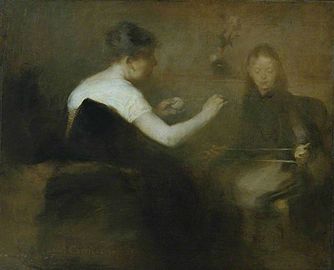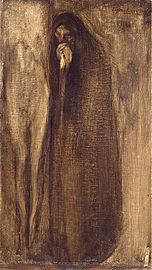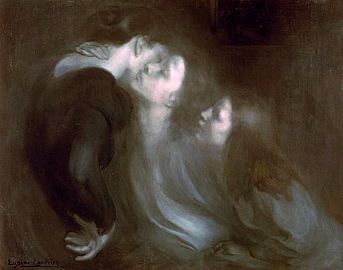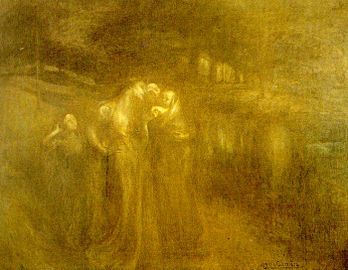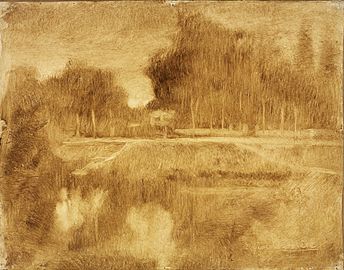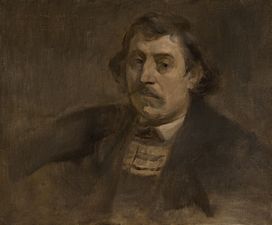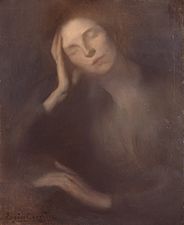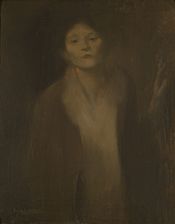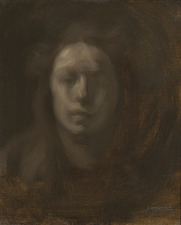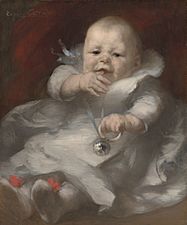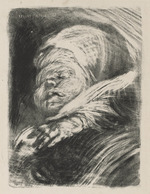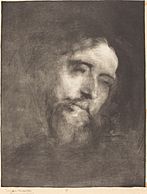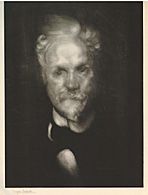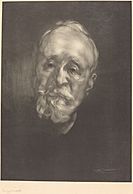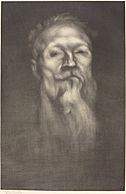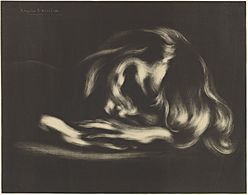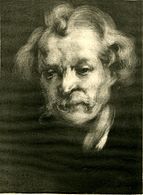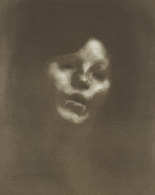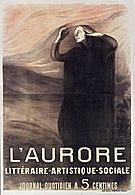Eugène Carrière facts for kids
Quick facts for kids
Eugène Carrière
|
|
|---|---|

Self-portrait (c. 1893), oil on canvas Metropolitan Museum of Art
|
|
| Born | 16 January 1849 Gournay-sur-Marne, France
|
| Died | 27 March 1906 (aged 57) Paris, France
|
| Known for | Painting, Lithography |
| Movement | Symbolism |
Eugène Anatole Carrière (born January 16, 1849 – died March 27, 1906) was a French artist. He was part of the Symbolism art movement. This movement was popular around the end of the 19th century.
Carrière's paintings are famous for their unique style. He often used a palette of brown colors. His artworks look dreamy and almost like they are floating. He was a close friend of the famous sculptor Auguste Rodin. His art might have even influenced Pablo Picasso's Blue Period. Carrière also knew many important writers of his time, like Paul Verlaine and Stéphane Mallarmé.
Contents
Who Was Eugène Carrière?
Eugène Carrière was born in Gournay-sur-Marne, France. He was the eighth of nine children. His father worked as an insurance salesman. Eugène grew up in Strasbourg, where he first learned about art. He studied at the Ecole Municipale de Dessin. This was part of his training to become a commercial lithographer.
Early Life and Art Training
In 1868, Carrière visited Paris. He was working as a lithographer at the time. He saw the paintings of Peter Paul Rubens in the Louvre museum. These paintings inspired him greatly. He decided then that he wanted to be a painter.
He began studying art at the Ecole des Beaux-Arts. His studies were stopped by the Franco-Prussian War. During the war, he was taken as a prisoner. After the war, he worked in the studio of Jules Chéret. In 1878, he showed his art at the Salon for the first time. However, his work did not get much attention.
Family Life and Growing as an Artist
In 1879, Carrière finished his art studies. He married Sophie Desmonceaux, and they had seven children together. They moved to London for a short time. There, he admired the works of J.M.W. Turner.
When he returned to Paris, it was hard for him to find success. He often had to work for printers to support his family. Between 1880 and 1885, his brother Ernest helped him. Ernest was a ceramic artist. He arranged part-time work for Eugène at the Sèvres porcelain factory. This is where he met Auguste Rodin. They became very close friends.
Recognition and Influence
In 1884, one of Carrière's paintings received an award at the Salon. A well-known art critic, Roger Marx, started to support his work. After this, Carrière became friends with many important artists, critics, and writers.
He helped start two important art groups: the Société Nationale des Beaux-Arts and the Salon d'Automne. He was even named honorary president of the Salon d'Automne. Carrière also taught art at the Académie de La Palette. He showed his art in many exhibitions across Europe. Some of his famous works include Sleep (1890) and Maternity (1892).
Carrière passed away in 1906 from throat cancer. Many important people attended his funeral in Paris. Georges Clemenceau and young artists like Francis Picabia were there. Rodin spoke at the funeral, praising Carrière's ideas. Carrière's last words to his children were: "Love each other wildly." After his death, several major exhibitions honored his work.
What Was Carrière's Art Style?
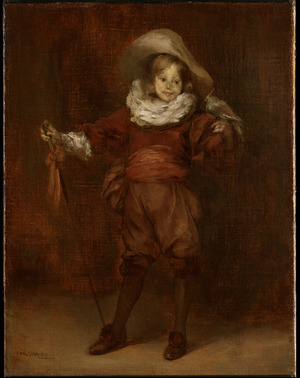
Carrière admired many old master painters. But early in his career, he was mostly influenced by his fellow artist Jean-Jacques Henner. Carrière started using a palette of mostly brown colors. He would add small touches of other colors. His painting style was similar to Henner's. By the mid-1880s, his art had a thick, misty brown look. Images seemed to appear out of this hazy atmosphere.
Themes in His Art
The Sick Child (1885) is a good example of his work. It shows a mother and her child. Carrière often painted this theme. It became a well-known part of his art.
Carrière was an important artist in the fin-de-siècle Symbolism movement. This art style began in the mid-1880s. Symbolist critics loved the dreamy, poetic feeling in his work. They said his art made reality feel like magic. Carrière was also involved in Symbolist theater.
He used soft colors and blurred details in his paintings. He surrounded his figures in a dark, thick atmosphere. This created a unique sense of space and light. His ethereal images often have a feeling of deep stillness.
Focus on Humanity
Carrière believed strongly that all people are connected. He saw his own family as a small example of all humanity. Most of his paintings show family members or family relationships. He focused on universal feelings rather than specific people. This often made his figures look less individual. They were placed in simple, undefined settings.
He also painted many portraits. Some famous ones include the poet Paul Verlaine (1890) and the sculptor Louis-Henri Devillez (1887).
You can find many of his works in museums today. These include the Musée d'Orsay and the Musée Rodin in Paris. His art is also in the Tate in London and the National Museum of Serbia in Belgrade.
Selected Paintings
Portraits and Figures
Prints and Graphics
See also
 In Spanish: Eugène Carrière para niños
In Spanish: Eugène Carrière para niños
- Auguste Rodin
- Paul Verlaine
- Stéphane Mallarmé
- Jean-Jacques Henner
- Picasso's Blue Period
- Léonce Bénédite
- Symbolism
- Fin de siècle


